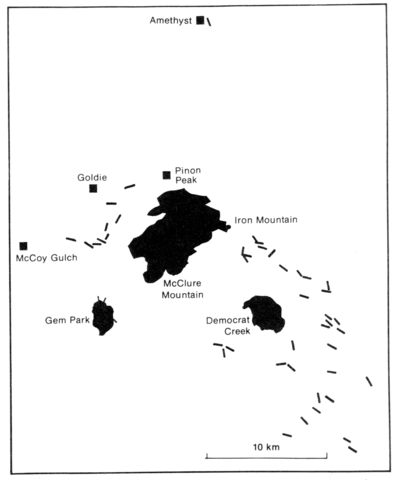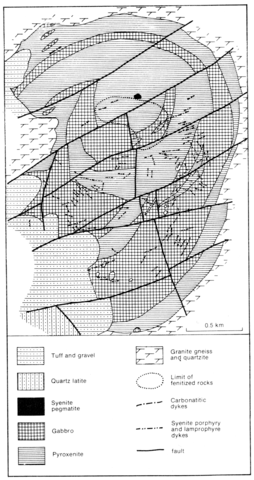stripes
Covering just over 3 km2, Gem Park is a funnel-shaped body emplaced in Precambrian gneissic granite, granite gneiss and amphibolite, which on the southern side is overlain by Tertiary latite flows, rhyolitic welded tuffs and water-laid tuffs. The complex consists of about equal proportions of layered, inwardly dipping, pyroxenite and gabbro, with one small mass of nepheline syenite and various lamprophyric and carbonatite dykes. The coarse and medium grained pyroxenite consists of clinopyroxene, amphibole, magnetite and minor labradorite, biotite, apatite, sphene and sulphides. Gabbros range from pyroxene-rich varieties close to pyroxenite to anorthosites (An69-54); a little olivine is invariably present and amphiboles may occur. The small area of nepheline syenite is a pegmatitic rock of perthite, interstitial nepheline, aegirine-augite, sodic amphibole, natrolite, analcime and sparse sodalite. A few dykes of spessartite occur within the complex but feldsparphyric trachytes with fibrous sodic amphibole are more common and are to be found within and around Gem Park. Carbonatite dykes are abundant within the complex and extend into the country rocks where they cause fenitization. They are all dolomitic but varieties with pyrochlore, pyrochlore plus blue sodic amphibole, apatite and baryte plus monazite can be distinguished. Many accessory minerals occur (Parker and Sharp, 1970, Table 3). A small carbonatite plug with a fenite aureole occurs at Pine Creek, approximately 1.6 km southeast of Gem Park. An extensive area of fenitization affects pyroxenites and gabbros in the north central part of the complex. The alteration is variable, the new assemblage comprising fibrous blue sodic amphibole, tremolite-actinolite, aegirine, phlogopite, vermiculite, dolomite, calcite, baryte, apatite and magnetite together with a range of accessories including lueshite, fersmite, natroniobite and thorianite (see Parker and Sharp, 1970, p. 14). Rock analyses are available in Armbrustmacher (1984a) and REE and Sr isotope data in Armbrustmacher and Hedge (1982).
ARMBRUSTMACHER, T.J. 1984a. Alkaline rock complexes in the Wet Mountains area, Custer and Fremont Counties, Colorado. Professional Paper, United States Geological Survey, 1269: 1-33.
ARMBRUSTMACHER, T.J. and HEDGE, C.E. 1982. Genetic implications of minor-elememnt and Sr-isotope geochemistry of alkaline rock complexes in the Wet Mountains area, Fremont and Custer Counties, Colorado. Contributiuons to Mineralogy and Petrology, 79: 424-35.
OLSON, J.C., MARVIN, R.F., PARKER, R.L. and MEHNERT, H.H. 1977. Age and tectonic setting of lower Paleozoic alkalic and mafic rocks, carbonatites, and thorium veins in south-central Colorado. Journal of Research, United States Geological Survey, 5: 673-87.
PARKER, R.L. and SHARP, W.N. 1970. Mafic-ultramafic igneous rocks and associated carbonatites of the Gem Park complex, Custer and Fremont Counties, Colorado. Professional Paper, United States Geological Survey, 649: 1-24


